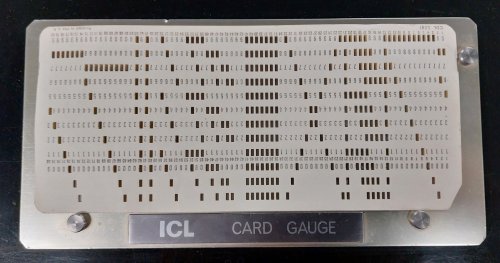A few miles from the centre of Milton Keynes, is another of those museums I've always fancied visiting. Since my time is my own, and I was down there already, the 20 minute drive seemed a sensible way to fill the afternoon.
Bletchley Park was home to the now famous WW2 code breakers, and there is a museum specifically devoted to this work, but that wasn't what I'd come to visit. No, I wanted a bit more nostalgia, in the form of computers that were around in my youth.
After a quick snack in the cafe (pre-packed sandwiches and mahoosive muffin), I paid my tenner and headed off into the hut.
First stop is codebreaking teritory with The Bombe. Now, this is a terribly important electro-mechanical computer. The replica (all the originals were destroyed by order of Churhill) is incedibly impressive. Chatting to the person looking after it, I had a demo, but still don't really inderstand what it is, or how it worked. I'm sure if I treid harder, all would be revealed, but it's kit from another age and the only bit of the display that really grabbed me was the tools and methods used to re-create the machine. That's not a criticism of the display, it's just not really my thing.
However, around the corner was very different. Proper mainframe machines. Probably less powerful than my phone, there is a terrific piece showing a 8 1/4 floppy disk and modern SD card memory capable ot hold the contents of 100,000 of the disks, and filling a room, this is what computers looked like when I was heading towards my O levels. At least, it's what business computers looked like.
I remember having to study this stuff for Computer Studies (we were repeatedly reminded that programming was only 20% of the marks, and computer history was more important) and so was exited to see a Ferrite Core memory module for the first time in real life. The impressive thing is that volunteers are restoring these machines to working condition.
You can get hands on with an early text adventure, in which I got lost in a forest. I can see how exciting these games would have been at the time though. Elsewhere you can try 1980s computers and games, plus a couple of arcade driving machines. All I proved was that I'm rubbish at computer games as usual, but that's not the point.
Less taxing, but very interesting is something I didn't think existed in working format anymore - the BBC Doomsday project. Running on a BBC micro and reading a laserdisk, I remember trying one in a library when they were new in 1986. At the time, it was "the future" but in the end, became a bit of a dead end. Reading through some of the entries, one problem was that they were created by schoolchildren, and as such aren't particually detailed, or even interesting today. A shame, but it's still good that someone gave it a go.
Looking at various home computers from the 1980s was great. Spectrums, ZX81's and some Commodore stuff of course, but also the Research Machines 380 and 480Z's we had at school. Also some of the rarer domesitic stuff that I recall, but am not sure I've ever seen for real. Anyone remember the One-per-Desk?
Moving on, there are displays showing how the interweb works and also a lot of air traffic control machines plus plenty of other bits and pieces. Everything is a reminder that all this new and shiny technology eventually ages, and becomes little more than junk to many people.
The whole place has the (welcome) air of something being run by keen enthusiasts. People who just like old IT kit. I loved it, and will defintely go back in the future.
The National Museum of Computing website.






2 comments:
Gosh! A real gem of a place Phil. Takes me back to keying in punch cards, taking them to the computer room to wait their turn to tun and then two days later getting a print out with an error report on card 2 and having to start again.
No doubt you saw the connection between the museum and model making especially with that last picture? Back in the 80s all those punch card chads from the cards became desirable as 4mm bricks. No doubt someone could brick a reasonable size model building with these chads in less time then it would have taken me to get a fully working punch card programme to say Woody is great!
I have a box of chads awaiting use one day, and was very keen toe see the devices for making them. If there had been an old one for sale, I'd have been tempted!
I did photograph a layout for BRM at Doncaster that used chads for bricks too, but I bet he had to explain them to the youth of today.
Post a Comment